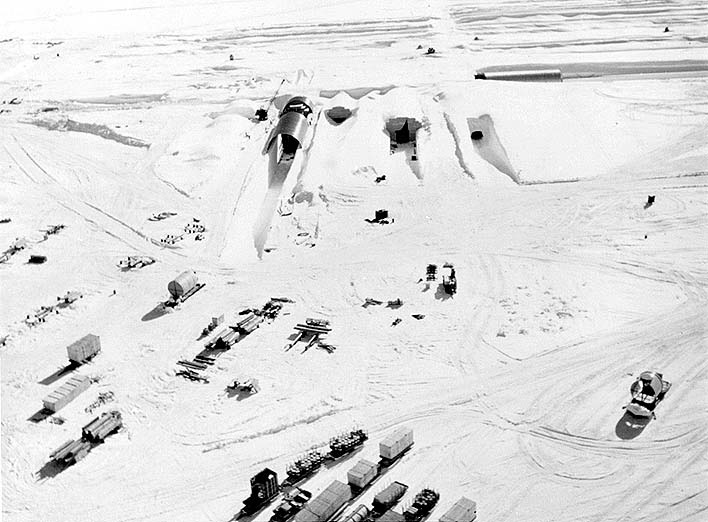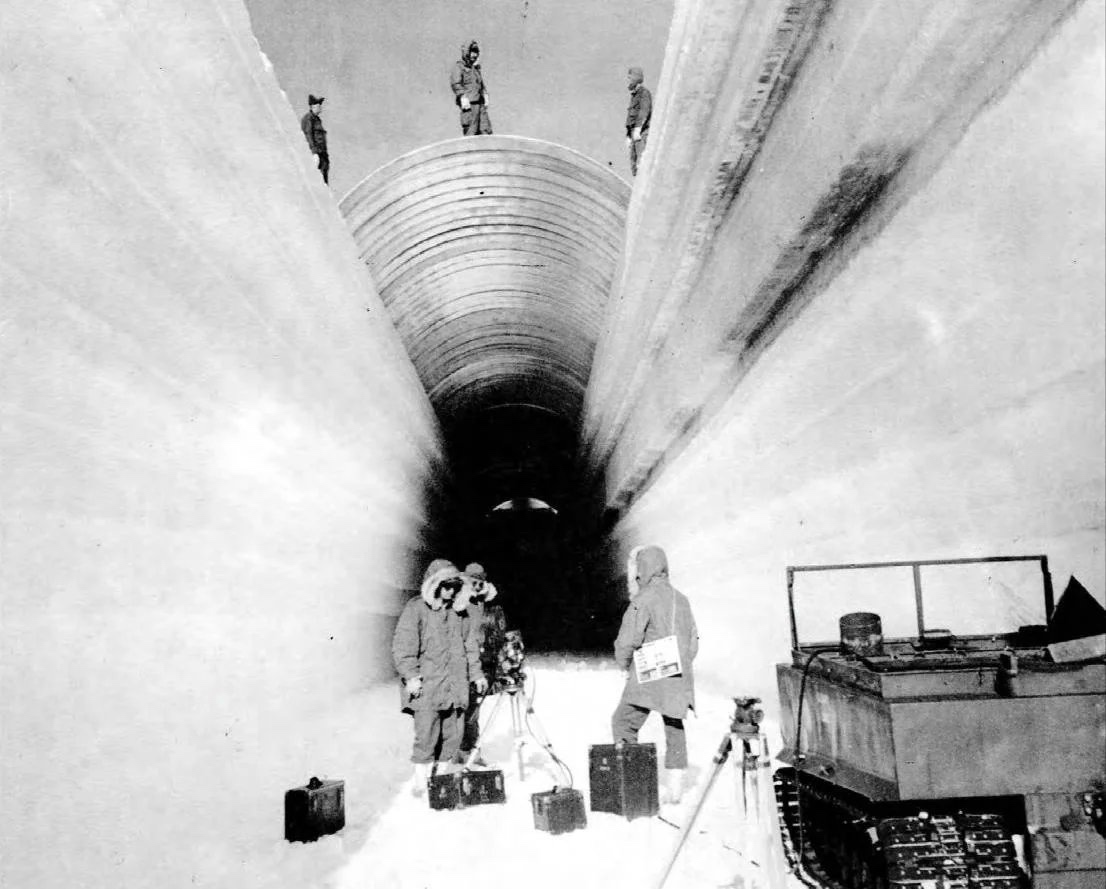In an accidental yet stunning discovery, NASA got a fresh and unexpected view of a Cold War tunnel built under the ice sheets of Greenland as part of the US military’s top-secret ‘Project Iceworm’ to store nuclear weapons.
A team of NASA scientists surveying the polar ice sheets in Greenland stumbled upon the abandoned “city under the ice” constructed by the US military for storing nuclear weapons during the Cold War.
The unprecedented discovery was made in April this year when NASA scientist Chad Greene and a team of engineers boarded a Gulfstream III to monitor radar equipment probing the Greenland Ice Sheet below.
The team was tasked with carrying out a scientific mission to measure the depth of the ice sheet in Greenland and the bedrock layers beneath it. During the mission, Greene photographed the wide, desolate landscape of the ice sheet from the airplane’s window while it was flying roughly 150 miles east from Pituffik Space Base in northern Greenland.
“We were looking for the bed of the ice and out pops Camp Century,” said Alex Gardner, a cryospheric scientist at NASA’s Jet Propulsion Laboratory (JPL), who helped lead the project. “We didn’t know what it was at first.” The photos taken by the aircraft provide a fresh perspective of Camp Century, a US military installation from the Cold War that consists of a network of tunnels cut straight into the ice sheet.
NASA said in a statement that aerial surveys conducted over Camp Century in the past have shown evidence of the base inside the ice. The agency explained that the traditional ground-penetrating radar employed in those flights created a two-dimensional profile of the ice sheet by pointing directly downwards. In that perspective, the substantial structures of Camp Century appeared like a blip in the distorted ice layer.
However, for the April 2024 missions, NASA installed UAVSAR (Uninhabited Aerial Vehicle Synthetic Aperture Radar) on the aircraft’s belly. This particular device is different and more potent in how it looks downwards and toward the side to create maps with greater dimensionality. This is how the abandoned site, referred to as a ‘Cold War relic,’ was discovered accidentally by NASA this summer.
The UAVSAR image provides a unique perspective on the condition of Camp Century after almost 60 years by displaying individual buildings that can be compared to the layout plans. Moreover, the discovery was not intentional. Greene said, ”Our goal was to calibrate, validate, and understand the capabilities and limitations of UAVSAR for mapping the ice sheet’s internal layers and the ice-bed interface.”
It is pertinent to mention that even though UAVSAR has provided fresh perspectives on Camp Century’s condition, the photos aren’t flawless. NASA observed that a band on the image gives the impression that Century is below the ice bed due to the angular nature of a portion of the capture. However, it is miles below the ice sheet.
Nevertheless, this discovery is important because it provides a fresh (and more lucid) look at the US-led nuclear operations during the Cold War, at a time when nuclear rhetoric is once again at its height and tensions have reached unprecedented levels between the US-led NATO and Russia.
Project Iceworm And The Abandoned Camp Century
During the Cold War, the military officials of the two nuclear superpowers—the United States and the erstwhile Soviet Union—constantly developed strategies to outmaneuver the other side in the heated rivalry that threatened to spill over into a full-blown nuclear escalation.
The US Army conceived a top-secret program known as ‘Project Iceworm’ in 1959. The objective of this project was to construct a network of mobile nuclear missile launch locations beneath the Greenland ice sheet that could launch a strike in case of a nuclear conflict and withstand a first strike from the enemy i.e., the Soviet Union (USSR).
This covert program envisaged a 4,000-kilometer (2,500-mile) network of tunnels that would be used to store (and launch) up to 600 nuclear missiles.
The program was based on the fact that the ice sheet covering Greenland would conceal the missile positions, which were to be rotated regularly. As history.com notes, “Pentagon planners thought that by shuttling 600 nuclear-tipped “Iceman” missiles (a new moniker for the existing Minuteman) back and forth between 2,100 silos, they could keep their counterparts in the Soviet Union guessing. Imagine a potentially deadly game of atomic “whack-a-mole” spread out across 52,000 square miles of northern Greenland.”

As soon as the program was finalized, researchers and engineers began investigating the viability of working beneath the ice. The Danish government, which controlled the territory of Greenland, was not given full details of the classified project. The US Department of Defense told Danish officials that Camp Century’s “official purpose” was to support scientific experiments on the ice cap, test different construction methods in the Arctic, and investigate real-world issues with a semi-mobile nuclear reactor.
After the site was chosen, hundreds of military engineers and technicians walked 150 miles to reach the Camp Century site from the nearby Thule Air Base on the northwest coast of Greenland. Between 1959 and 1961, they excavated hundreds of feet under the compacted snow to ostensibly create a subterranean city with sleeping quarters, offices, laboratories, a barbershop, a library, a laundry room, and warm showers for 200 soldiers.
Massive, deep trenches were dug out, and the underground city was covered with steel semicylinders coated with snow and ice that solidly froze them into place. From 1960 to 1963, the world’s first mobile/portable nuclear reactor, the PM-2A, which was built by Alco for the US Army, supplied the electricity for this project. Meanwhile, the water came from the glaciers.
The trenches were designed for a type of modified Minuteman IRBM missile known as “Iceman,” which could endure the pressures of launching through the ice sheet. According to an article titled ‘The Iceman that Never Came’ published in the Scandinavian Journal of History in 2007, “The key concept was to deploy the missile force in ‘thousands of miles of cut-and-cover tunnels,’ or rather covered trenches, whose floor would lie 28 feet beneath the surface.“
The Iceman Could Not Be Stationed In Greenland
However, the project never reached completion. In an unforeseen event at the time, the snow and ice walls continued to move, squeezing the lines that transported the missiles, forcing the termination of Operation Iceworm.
By 1966, the US Army had completely abandoned Camp Century. The Iceman missiles, which had the potential to hit targets within the Soviet Union, were never deployed.
A set of documents released by Denmark in 1997 referred to a 1960 US Army report titled “Strategic Value of the Greenland Icecap,” which outlined the idea of the US Army’s “Iceworm” missile network. The report stated that when the project is finished, it will span 52,000 square miles or about 130,000 square kilometers, about three times Denmark’s size. The launch complex floors would be 28 feet (8.5 meters) below the surface.
Moreover, the report noted that clusters of missile launch sites would be separated by 4 miles or about 6.4 kilometers. According to that report, the US planned to dig new tunnels annually, resulting in thousands of firing points within five years, from which several hundred missiles could be launched. The iceman was to be deployed in these tunnels.

Greenland was chosen because it was far closer to Russia than the mainland United States, and the Iceman ICBMs could have instantly hit nearly any target in the Soviet Union. Moreover, the planned Iceworm complex’s enormous scale and the missile’s comparatively broad distribution would guarantee the US’s second-strike capability in addition to strengthening the land-based leg of the US nuclear triad.
Denmark, at the time, had a policy against nuclear weapons on Danish soil despite allowing the US military to use Greenland as a staging area. Since the project was abandoned, no permissions were taken for the deployment of nuclear missiles under the ice sheets of Greenland, according to reports.
As Camp Century was abandoned, weapons, sewage, fuel, and other pollutants were buried there. Several scientific predictions have been made, suggesting that the Camp Century ice will start to melt by 2090, causing radioactive and human waste to spill into the ocean. In 2017, the US government said it “acknowledges the reality of climate change and the risk it poses” and that it would “work with the Danish government and the Greenland authorities to settle questions of mutual security” regarding Camp Century.
For now, NASA says the tools it employed that led to this discovery should assist researchers in determining the thickness of ice sheets in comparable Antarctic conditions and making projections of future sea level rise. “The test flights that captured Camp Century earlier this year will enable the next generation of mapping campaigns in Greenland, Antarctica, and beyond,” the statement added.
- Contact the author at sakshi.tiwari9555 (at) gmail.com
- Follow EurAsian Times on Google News




